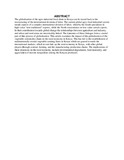Planning For Agro-Industries in Kinangop Sub-County, Nyandarua County – Kenya
Abstract
Agro-industries catalyse rural development in areas with abundant agricultural raw materials, making these industries popular in poverty reduction. These industries create demand for inputs in the farm from other sectors, requiring deliberate planning, but it is not always the case, even in countries that have devolved planning functions. The "Nyandarua District Integrated Regional Plan (NDIRP)" and "Nyandarua County Integrated Regional Plan (NCIRP) 2, 2018-2022" were inventoried for data on planning for agro-industries in Kinangop sub-county. The District Integrated Plan and the County Integrated Plan had 15 and 29 agro-industrial planning interventions in five areas of action planning, respectively. The planning interventions in the district-integrated plan were disaggregated to the sub-county around four regional strategies and the five areas of action planning. This makes the plan more resourceful in planning for agro-industries compared to the County Integrated Plan. Data on social characteristics, agricultural production, and marketing and data on the location and sighting of six agro-industries were inventoried from a study report on planning for agro-industries in the sub-county. Over 80% of respondents grow potatoes, cabbages, carrots, maize, and snow peas; and rear dairy cows to produce milk for their own consumption and surplus for the market. Myriad challenges, including exploitation by middlemen and lack of appropriate land sites for agro-industries, undermine the agricultural production efforts of the farmers and the development of agro-industries. The article recommends planning for agro-industries that disaggregates strategies and areas of action planning to sub-county level or below to address location and site accessibility needs of agro-industries as a norm of territorial rural development.
Publisher
University of Nairobi
Collections
Related items
Showing items related by title, author, creator and subject.
-
Planning for Agro-industries in Rural Communities: the Case of Kinangop Sub-county, Nyandarua County
Gitau, J. (University of Nairobi, 2020)Agro-industries are important vehicles in rural development. They enhance food security and employment creation in off-farm activities, thereby boosting levels of income and government revenue that is generated from the ... -
Valuation practice: challenges in plant and machinery valuation in the agro-industrial sector of Kenya
Okoth, Michael W; Mutuli, Daniel Amedi (Department of Food Technology and Nutrition, 2003)The aqro-industrial establishments in Kenya have invested heavily in plant and rnachinery as a strategy for achieving optimum productivity. Plant and machinery refers '(0 installations anel :='_I)port facilities for ... -
The Socio-economic and Ecological Impacts of the Agro-industrial Food Chain on the Rural Economy in Kenya
Opondo, Mary Magdalene (Faculty of Arts, 2000)The globalization of the agro-industrial food chain in Kenya can be traced back to the restructuring of the international division of labor. The current global agro-food industrial system entails aspects of a complex ...



